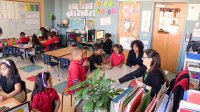Optimizing Station Rotations in Blended Learning
Using three stations effectively—teacher-led, online, and offline—should provide your students with plenty of ways to collaborate.
Your content has been saved!
Go to My Saved Content.Interested in blending learning models?
A three-station rotation model is a valuable tool for teachers who want to integrate technology, writes former Teacher of the Year and author Caitlin Tucker on her blog. The tactic moves students through different areas of the classroom: teacher-led stations, online stations, and offline stations. While this blended learning model “creates a nice balance between online and offline work,” says Tucker, "it is easy for teachers to slip into a rut when it comes to designing their stations.”
Tucker identifies common pitfalls and possible solutions:
The teacher-led station: Just because a station is teacher-led doesn’t mean the teacher should do all the talking; it’s not all about direct instruction. Encourage students to engage and collaborate. Model a practice and then have students try the same practice in pairs. Or use the teacher-led station for immediate feedback on a recently completed piece of writing, completed homework, or a lab assignment, either through formal assessments or informal Q&A sessions. The teacher-led station is also a great opportunity for differentiated instruction: even if the activity is the same, give different students different instructions tailored to their particular needs. Scaffolding in small groups or moving around the group to observe students individually as they try to complete a modeled task allows teachers to cater to individual needs.
The online station: One common pitfall in the online station is using it “exclusively for personalized practice using adaptive software or an online program." Asking kids to work on computers or tablets in isolation can be limiting and de-motivating. Find ways to make technological integration collaborative, Tucker says, and focus on activities like designing, creating, and publishing digitally. Using technology to support project-based learning, for example, ensures that students interact with each other and not just with screens. Interactive games and quizzes where students play with each other, like Kahoot, can build knowledge while encouraging student interaction. Social media platforms can be a useful tool for engaging with experts as well.
The offline station: The offline station is often dominated by independent work on paper. “Instead of designing collaborative tasks that allow students social learning opportunities, they are required to practice without support or peer interaction.” Like the online station, the offline station works best when students have an opportunity to engage with others and receive guidance. Art projects, STEM experiments, or in-depth discussion allow students to work together and engage in deeper learning.
